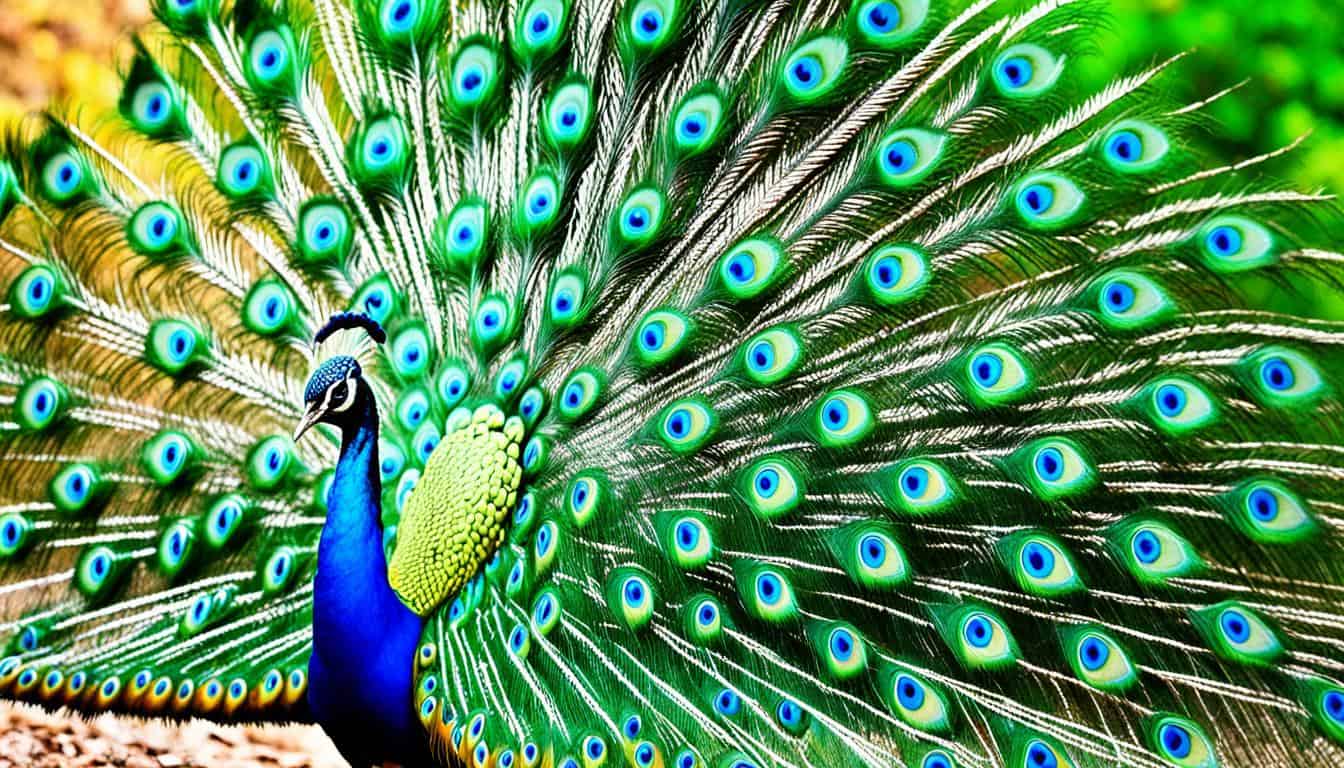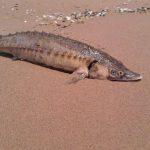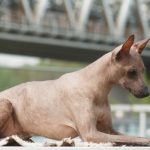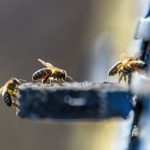The fascination with native peacocks in the USA comes from seeing them in cities. These sightings make people wonder where they came from and how they affect the environment. It’s key to know that peafowl are not originally from North America. Yet, they are in some areas now because they were brought there in the past. This has caused different views on their presence.
Introduction to Peafowl in the USA
Peafowl are a surprising but beloved part of the American scene. With their glorious feathers and captivating shows, they bring a touch of luxury and mystery. They arrived in America many years ago and have since made their mark on the land.
History of Peafowl in America
The story of peafowl in America started with the first settlers, who brought them for beauty. These birds grew to symbolize wealth and class in the country. Elias J. “Lucky” Baldwin was a big part of spreading them, especially in Southern California.
The Role of Peafowl in Ecosystems
Though not from North America, peafowl have made themselves at home here. They live in various landscapes and impact their surroundings, both good and bad. They help control pests but may also disturb local wildlife.
By learning about where peafowl naturally live, we understand how they fit into new areas. They like to rest in tall trees and search for food on the ground. This behavior affects the plants and animals around them. Seeing where peafowl are in America helps us understand their place in the ecosystem.
Origins of Peafowl in North America
Wild peacocks first came to North America through early settlers and rich landowners. They brought these birds from South Asia to the lush landscapes of the United States.
People brought peafowl for their stunning colors and practical uses. They soon became part of the large lands owned by people, adding beauty and benefits.
Importation by Early Settlers
Early American settlers found exotic birds fascinating. Peafowl, with their bright feathers, were especially desired. They were used for their looks and benefits.
Elias J. “Lucky” Baldwin and Peafowl Introduction
Elias J. “Lucky” Baldwin was a key player in bringing peafowl to the USA. In the 1800s, he brought peacocks to his big estate in Southern California. These birds helped control pests and warned against predators.
Many peafowl eventually got free and formed wild populations. Now, North American peacocks, especially in Southern California, are mainly from Baldwin’s peafowl. His action led to a rich mix of exotic bird species throughout the country.
Wild Peafowl Sightings in the USA
Wild peafowl sightings are on the rise in the USA. The American peacock is seen in warm places like Southern California, Miami, Austin, and Honolulu.
In these regions, people often see peafowl in the streets or on roofs. These birds mix with the locals. This mix of wildlife and community can be both enchanting and sometimes troubling. In places like Los Angeles County, people have gotten used to peafowl sightings. They find them fascinating.
Peafowl have adapted well to various environments in the USA. They catch the eye of bird lovers and researchers alike, whether in busy city centers or quieter areas. The presence of these birds shows how they have become part of the American scene. People are affected by the American peacock in different ways. That makes their population’s impact significant across the country.
Are there any native peacocks in the USA?
Peafowl mainly live in the USA’s warm regions, which suits their needs well. They are not native birds here. Instead, they were introduced from afar. Even so, they have thrived and found a home in these lands. This shows how adaptable these beautiful birds are.
Distribution of Peafowl Populations
Warm states like California, Florida, and Texas are peafowl favorites. Thanks to these places’ mild weather and food availability, they have made themselves at home. But remember, they are not originally from North America.
Comparing Peafowl to Native Birds
Peafowl behave differently from local birds. They come from elsewhere, but they’ve adjusted well to life here. Though they are not native peacocks USA, they have their own place. Still, their presence can cause challenges for the natural balance.
| Attribute | Native Birds | Introduced Peafowl |
|---|---|---|
| Origin | Native to the USA | Introduced from Asia |
| Ecological Role | Integral to local ecosystems | Adaptable, but non-native |
| Impact on Habitats | Sustains local biodiversity | Can impinge on native species |
| Population Control | Balanced by natural predators | Often lacks natural enemies |
Peacock Habitat in the United States
The peacock habitat in the United States is shaped by many factors. Climate and the availability of food play a big role. The tolerance of these birds by people also matters a lot.
Preferred Environments
Peafowl look for places with lots of space and tall trees for roosting. They prefer open areas and high perching spots. This is similar to their peacock natural range. Places like suburban gardens, parks, and estates are perfect for them.
Urban vs Rural Settings
In big cities, peafowl find plenty of food and less danger from predators. This draws them to places like Los Angeles and Miami. Urban areas offer a mix of city life and wild nature thanks to their growing peafowl populations. But, these birds face more threats from predators in the countryside. Also, finding food can be hard, affecting where they live.
| Aspect | Urban Settings | Rural Settings |
|---|---|---|
| Food Availability | High (Gardens, human foods) | Variable (Natural foraging) |
| Predators | Low | High |
| Roosting Sites | Plentiful (Tall buildings, trees) | Moderate (Trees, natural shelters) |
| Human Interaction | Frequent | Infrequent |
| Population Management | More controlled | Less controlled |
Looking at these points helps us understand the life and struggles of wild peacocks in North America. It shows how different places affect them.
Challenges of Living with Peafowl
Living with peafowl in urban or suburban settings can be hard. It brings several challenges that affect our daily life in many ways. The presence of these exotic birds changes our living experience.

Noise Complaints and Nightly Disturbances
Peafowl’s loud calls, especially during mating seasons, annoy many. Peacock noise disturbances can be heard far and wide. They disrupt sleep and daily activities. This can cause frustration.
These calls become worse in the mating season. This period runs from early spring to mid-summer. During this time, their calls are more persistent and intense.
Damage to Property
Peafowl property damage is a big issue too. They are territorial and often damage cars and gardens. They peck at shiny things, leading to scratches on cars and damaging windows.
Their foraging also ruins gardens. This affects the look and upkeep of our living areas. These issues show the challenges of living with peafowl.
In places like the United States where peafowl are common, dealing with these problems is very important. We need to find ways to live with these impressive yet challenging birds.
Management and Control of Peafowl Populations
As peafowl numbers increase in many areas, it’s crucial to keep their population in check. This is key for everyone to live together peacefully. Management plans change based on rules and how much the community helps.
Community Measures and Ordinances
Community peafowl ordinances have been set up in many places to handle seeing these birds around. These rules might state where to not feed peafowl, or that feeding them is not allowed. This is to make sure the area is good for both the people and the peafowl.
Feeding Bans and Trap-Relocate Programs
Stopping people from feeding the birds, through peacock feeding bans, is a smart way to not let their numbers get too big. Also, places like Los Angeles County and San Antonio have started peafowl trap-relocate programs. This means capturing the birds and moving them to spots where they’re not as bothersome to people.
| Community | Measure | Outcome |
|---|---|---|
| Los Angeles County | Feeding Ban | Reduced population growth |
| San Antonio | Trap-Relocate Program | Fewer human-peafowl interactions |
The key to making these strategies work is for everyone to pitch in. A mix of rules, feeding bans, and moving the birds helps to find a middle ground for living together.
Impact on Local Wildlife and Ecosystems
Adding peafowl to new areas can change the environment a lot. They often fight with local species for food. This can shake up the natural order, affecting who gets to eat and why.
Peafowl also munch on plants, which isn’t great for the local greenery and the animals that rely on them. This can mess up the food and shelter situation for other wildlife. If they show up in towns, their impact becomes even more serious.
In places where they have no predators, peafowl can take over. This puts more pressure on the environment and the creatures living there. Even if they don’t directly harm native birds, their presence poses big challenges.
To really get the problem, we need to focus on how peafowl interact with the local wildlife. Here’s a breakdown:
| Impact Area | Description |
|---|---|
| Competition for Food | Peafowl compete with native species, reducing available resources. |
| Vegetation Disruption | Foraging behavior disrupts gardens and native plant habitats. |
| Population Growth | Absence of natural predators leads to unchecked population growth. |
| Minimal Native Bird Interaction | Studies suggest minimal direct impact on native bird populations, but ecosystem disturbances persist. |
The issues caused by these birds go beyond the simple fight for resources. We must think carefully about how to manage and protect our wildlife. This way, we keep our ecosystems healthy and balanced.
Exotic Bird Species in the USA
In the USA, exotic birds show a mix of human and nature’s work over time. Among them, peafowl stand out. They live alongside the Monk Parakeet and the European Starling. These exotic birds differ in how well they fit in, their impact on nature, and the problems they can cause.
Comparison with Other Exotic Birds
Peafowl and European Starlings affect the environment in different ways. Peafowl live steadily in towns. Yet, European Starlings are seen as a threat. They compete fiercely with local birds for their needs. Starlings can mess up local life more than peafowl do. Monk Parakeets, on the other hand, are noisier in groups but less troublesome. Even so, they can thrive in cities, complicating things. Peafowl might not cause as many issues, but they do change their living environments.
Regulations and Environmental Concerns
The USA has set rules to handle these exotic birds. The focus is on keeping the local environment safe and keeping the balance. Both the national and local rules are key to dealing with birds like peafowl. For instance, there are bans on feeding in towns to stop their numbers from growing too much. This helps prevent trouble for the environment. These rules also aim to avoid spreading diseases. So, they try to keep the peace in nature while dealing with the unique issues these exotic birds bring.
FAQ
Are there any native peacocks in the USA?
No native peafowl live in North America, including peacocks and peahens. Settlers brought them for their looks, and they now live wild in some places.
What is the history of peafowl in America?
Early arrivals to America introduced peafowl for beauty and use. Baldwin, a key figure in California, let them roam his property from India.
What role do peafowl play in ecosystems where they are found?
Peafowl affect ecosystems both positively and poorly. They matter in food and space against local creatures and may hurt plants and small animals.
How did early settlers contribute to the presence of peafowl in the USA?
Settlers brought peafowl for beauty and practical reasons. They used them to control pests and warn of dangers. Some ran off to make new homes in the wild.
Who was Elias J. “Lucky” Baldwin and what was his role in the introduction of peafowl?
Baldwin was an important rancher in 19th-century Los Angeles. From India, he imported peafowl to his estate in Southern California. This helped the birds spread in the area.
Where are wild peafowl sightings most common in the USA?
You’ll see peafowl more in warm urban and suburban spots, like parts of California, Miami, Austin, and Honolulu. These areas suit them with the right weather and lots of food.
How are peafowl populations distributed in the USA?
Peafowl like places with good weather and food. They do well in towns and suburbs where they’re safe from their usual predators.
How do peafowl compare to native birds in the USA?
Peafowl are not like local birds in their way of life or the things they do for the environment. Sometimes, they can cause problems by changing the ecosystem or fighting for food.
What are the preferred environments of peafowl in the United States?
Peafowl like places with plenty of ground to find food and high trees to sleep. Towns and cities can be perfect because they offer food and few predators.
What are the differences between urban and rural settings for peafowl habitats?
Urban areas give peafowl more food and safety and so more chance to grow in numbers. In less crowded areas, there’s not as much to eat or places to hide, so fewer peafowl live there.
What challenges do residents face when living with peafowl?
If people live among peafowl, they might have to deal with loud calls and birds messing with their property. This can lead to fights in the community over how to deal with the birds.
How do communities manage and control peafowl populations?
Places deal with peafowl through things like not letting people feed them and moving them somewhere else. Local laws might also cover how to handle peafowl to lessen their impact on living conditions.
What impacts do peafowl have on local wildlife and ecosystems?
Peafowl may take food and homes that belong to local animals, disturbing the natural order. They can also harm gardens and the creatures that live there.
How do other exotic bird species compare to peafowl in the USA?
Not all exotic birds in the USA affect the local area the same way. Some, such as peafowl, change local life more while others find their place with less trouble.
What regulations address environmental concerns related to peafowl?
There are rules at both the federal and local level that balance protecting nature with people’s needs and safety. These rules help manage exotic birds like peafowl to prevent harm to the environment and the spread of diseases.







